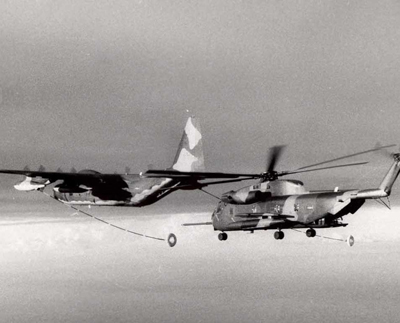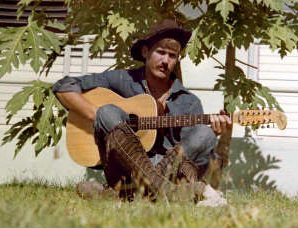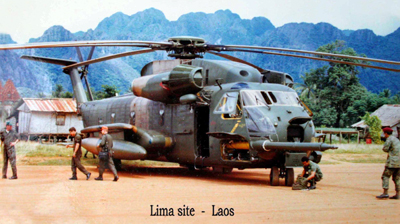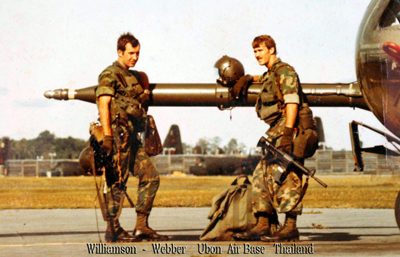|
George Webber ('69) He was born in 1950 in Inglewood. His mom was a shy Kansas girl. His dad had no idea about the concept of family, so life was stressful at home. He spent weekends feeling ‘safe’ at his aunts, but he knew he’d have to leave home as soon as possible. Due to one year of having taken advantage of flexible scheduling, he was shy a few credits. So, graduating in June of ’68 became graduating in Feb. of ’69, class of 1. He was in love with a girl from IHS but still or because of her, he joined the Air Force. He wanted choice of service and army grunt just didn't sound appealing. Plus although never a terrific student, he did above average on the AF test. He’d hoped to get into computers (it was new tech at the time) or electronics. It would be a good move for their future. So, in ’69 he took off for basic training to Lackland AFB, TX. A couple weeks in, he got a 'Dear John' letter. She’d misspelled his name.
There hadn’t been a Para Rescue Jump class in a long time. At any given time, there are only about 300 in the field, working in 2 man crews, with support from the Air Force when available. Most were weeded out during the entry process and were whittled down to 12. The 1st month was spent getting stronger and increasing endurance. There are a handful of tech schools to pass before going to the PJ transition school. This process would last for the better part of a year, being evaluated every step of the way. This was to be a learning and life building experience about real world stuff. His 1st school was jump school at Ft. Benning, an army base that trains all branches of the armed forces. The PJ’s had a 2 story barracks all to themselves. Being a little more 'pumped' than the usual herd of recruits, they all breezed thru.
On the weekends they had boxing events to entertain the troops and if you participated you didn’t have KP duty. He’d never boxed, but it seemed worth it. The 1st fight was between the 'big boys'. One guy had been smacked all over the ring by the 2nd round. George almost caught his mouth guard as it flew out of his mouth. He’d started having 2nd thoughts, but George held his own AND avoided dishpan hands.
Army Rangers Mt. Climbing School in GA was next. It felt like a Boy Scout Jamboree, learning knots and stuff. But looking over an overhang or dangling off a cliff brought you back to reality. He and his partner Willy impressed the 'boss' by leap-froggin' to cut down climb time. They slept on the mountain, tethered to a safety line. The line froze in a small stream. Did I mention he hated the cold too? They all got back safely. Finally, time to relax at Combat Medical School at Shepard AFB, TX. It was 6 weeks of books and classroom work where George received an outstanding achievement award for scoring in the high 90's for the course. He’d made his Momma proud. Now, onto Air Crew Survival Course in Spokane, WA, for tactics and protocol, followed by a week in the forest, making compass headings, finding meeting points and finding friendlies, all while surviving on minimal rations. They went through a mock POW situation that really opened his eyes on mind control, manipulation and what you may have to do to keep alive. You’d better have tremendous inner strength. Finally, training finished off with a 'Tactical Mission' put on by the PJ instructors at Eglin AFB, FL. They were put through a rough week long mission in the wild. Time was spent jumping in on a 'survivor', treating and transporting them by improvised litters and rafts, to a safe location. They all persevered and got their maroon berets. He’d like to point out that, yes, he alone will go down that cable to retrieve an injured pilot, but it is the dedication and training of a whole bunch of brave people that gets him close enough to do his work. This was NOT a single person project. This is how he got from good old MHS boy to the good old boys in PJ Rescue. By then he was turning against the war un-effort. But this was the mission he’d trained for. Although he felt Washington was killing our young, it was his job to save those he could. He got one month off before reporting to their 1st real PJ operational unit. Now, it’s real! There is a thin line between the total exhilaration of a successful mission and a dreaded debacle. Four PJs headed for Clark Air Base in the Philippines. That base supported the war effort and ferried planes and equipment in country. George was known at MHS as one who pushed the envelope, questioned rules and authority. Not too much had changed. When the Sgt. came to pick up the new guys, he looked at George and said the “boss man” is gonna love YOU! His ‘cookie duster’ had extended past the corners of his mouth and he’d let his hair grow long. Some of the old guys hated the ‘hippie types’ so when he put on his civvies, they almost infracted! George wore a big leather hat Joe Adams (‘67) had made, a pair of knee-high sow-skinned boots and an old leather vest with fringe. It was this outfit that made the base commander at the diving school restrict him to base. Now the “boss man” put George on his list of those who pulled assignments on every holiday. But George vowed to never change. Being a PJ was a great feeling. He’d imagined growing up around where all the WW II aviation had been located. It aroused his ambition to go airborne. Flying and jumping ran thru his veins. His mission was flying ‘Duck-butts’, escorting and air refueling jet fighters. He took supplies to bases in country, did general South Pacific area rescue missions, provided local medical support, aided in Apollo spacecraft retrieval and his troop practiced drone pick-ups. It felt like being in the Boy Scouts but with no adult supervision.
George got around base in his old ’49 Plymouth and picked up a chopped Harley ’45 w/bastardized parts (to keep it running). The on-base motorcycle club was irate. Yes, banned again. For dive training, they’d grab a truck from motor pool or snag a helicopter ride to the jungle. All aircrew personnel were required to attend Pacific Jungle Survival School, spending a week in the jungle with Negrito tribesmen. They were taught about jungle living and survival. Both survival schools had ‘Or Else’ stories. One reminded us of the “one” who froze on the wet ground by ignoring basic rules. In the toasty jungle, they had a guy die from a bite from the Bamboo viper. One must be aware of your surroundings and situation and act accordingly. This tour was pretty quiet and felt like the calm before the storm. Difficult missions did arise, but by now, the 4 from PJ class 70-3 were focused on their next assignment. But first, a month off where George got to see his main peeps, his family, the crew, the Fair Befall band with Denny Morell and Chaz Stevens (both ’68). Other MHS players filtered thru that band thru the years. Dave Dickerson, Skip Yutkus, Joe Adams, Barb Lopez, Bob Gisonno and Mike Rosatti. It was time to pack and head back. As he was walking down the tarmac towards his ride back to the jungle, he noticed good ‘ol mom break thru the roped off perimeter line to run up and give him one last hug. He thought “Jeepers Ma, here in front of everybody?” Bless her lovin’ heart. George was shuttled to Bangkok to await a flight heading to Udorn, Thailand. He was to man the western portion of the Ho Chi Minh trail, from Cambodia to Hanoi. Steve Rhody and Bill McDonald, PJ classmates, had already filtered thru there, on the way to DaNang. What a wild town. Seeing other cultures and lifestyles had always been an interest to him. It was reality with all his senses involved. Being the new guy, he had a lot of training on the incredible HH-53 heavy-lift helicopter. Early rescue in the war consisted of the use of Pedro, a fire suppressant chopper. It barely held 4 and usually had just a fire retardant bottle to extinguish crash fires and only about a 50-mile radius of operation. It was un-armed, underpowered and un-armored.
Within a couple years, Sikorsky came up with a major improvement in capabilities and safety. The H-3 was bigger, more powerful, armored, armed and air refuelable. George thought there still was room for improvement. Someone read his thoughts. The enlarged HH-53C was developed. But there still was room for improvement. With all the new equipment being developed it needed more room and power. They enlarged the craft. PERFORMANCE Maximum speed: 196 mph Cruising speed: 140 mph Range: 540 Miles Service Ceiling: 20,400 ft. Although it made for a big fat slow target, it took a lot of abuse. George called it his ‘chariot’. George was at the base where they flew out of on the Son Tay mission to try and retrieve POWs. But the prisoners had been moved, so none were recovered. All things a PJ is doing can be dangerous, but in a war zone a few more things will pop up, lead poisoning being just one of them! But with all the danger came the beauty of the land. Riding around in a big helicopter lends itself to just eyeballin’ the countryside. George has thought about going back, many times. There were a few non-war type missions that happened to support locals that had ordinary accidents, like broken legs, etc. He’d stabilize them and fly’m back to a hospital. There was never a dull moment. “Sometimes things didn’t go too good, but coulda been way worse”. George wore goggles that allowed him to see only shades of black, gray and lime green. But he did see his buddy and a survivor skidding thru the dikes, spraying water and hitting the next dike before the cables got cut and the pilot regained control of the aircraft. A backup chopper than came in and used lights to retrieve the 2 survivors. I remember my buddy Willy asking the downed pilot, “So, how’d you like your 1st rescue?” He recalls one particularly bad day. An F-4 fell off radar in ‘friendly’ territory. George followed the plume in the horizon to a hole punched into the earth. There was only recovery left to do on this job, and not much of that, nothing much recognizable. It took a while to tell the difference between man & machine, but the word we got was “Get what you can”. We loaded up the body bag with just parts and pieces. There was nothing more that could be done. Later that day a mayday came from a ‘last flight’ C-47 that was celebrating somebody’s end of tour. An engine had gone out and instead of the pilot cutting the bad engine, he did the good one, lost power, crashed & burned. By the time he got there it was fully engulfed in flames, too hot to get near. He could see the pilot turn into red glowing ash. Once again, nothing more could be done.
We all live forever, unless our number comes up. During his 2nd tour there were a lot of air strikes during some of the heaviest air war activity to date. A lot of missions were going on around Hanoi, so they had to fly with terrain masking (camo) to keep out of SAM sites, but that sticks them into small arms fire range. There were anxious moments when you could hear the sound of popcorn and little holes started appearing in the skin of the aircraft. On one of these missions, another chopper took some hits, one round coming up thru the floor and into the Flight Engineer standing at the door. It also hit a fuel line, so it was time to leave. The shot up helicopter refueled with the HC-130 many times before reaching Laos where F.E. Cash received an emergency transfusion, before getting to a hospital in Udorn. About this time, most of the other PJs George came with were ending their 1- year tour and being assigned either stateside or to another foreign country base. George knew at this point that he could never go back to anything normal. Things were different than when he’d first arrived. He saw things as they were, didn’t believe a lot of what had always been told to him, but the mission of the PJ was ultimately, here. So, he volunteered to go around on this crazy-ass ride one more time! Mu Gia Pass, Catcher’s Mitt, A Shau Valley, places that conjure up memories and feelings of dread to those that had to spend much time there bith on the ground or in the air. ‘Hamburger Hill’ and the Ho Chi Minh trail were both highly protected passes held by the NVA and all undesirable locations for the ‘round-eye’.
By this time, all of the PJ’s in George’s class were gone, except Dennis Wiiliamson. There was still no end in sight for the air war that was still going strong, so the missions continued. George was starting to question the tactics and goals of this mad circus. The cynical stirrings that he’d cultivated for all those years seemed to have started during this time. Da Nang lost a crew on the onset of Bat – 21 in April that was trying to cross down in Cambodia, but it took a hit from something, as the lead Jolly Green turned back to find the reason of ‘No response’ on the radio. They found a black plume of smoke in the trees, 1 parachute stretched across the top of the tree canopy, un-opened. One PJ apparently made it out and landed in a tree. The letdown tape (a device to lower you out of the trees) was used, but they couldn’t find the PJ or his body. George had heard a team was supposed to check, but he never received a satisfactory report of what really happened. The Air Force had a ceremony for them, but George could never get it out of his head as to who made it out, or where they went. Kinda pissed George off. He was sure they told the mother he’d died. We were ALL warned: ‘You could be next’! In keeping pro-efficient in all the PJ duties, sometimes you’d have to go to bases that had the resources to maintain skills & meet requirements. Being land-locked at his base in Thailand, George had to go to PJ Square in DaNang to do sea/hoist pick-ups. There were a couple PJ’s still there, and it was good to see them. The base was a war base, for sure. Off base you had to fight VC, NVA and Jane Fonda. On base, you had incoming rockets, + white, black and brown people problems. You used to be able to wander around town freely, but that was now SUPPOSED to be off limits. Being from out of the country, young and stupid George and Willy got off the bus. Angels sat on their shoulders or God watched out over the crazy & the lame. George kinda fit into all those categories. They made it down to China Beach. Nothing like Hermosa, Manhattan or the P. V. cliffs, but as relaxed as a war torn vacation get-away can be! The Hueys flying overhead kept you in the moment. You NEVER got used to the bad things that happened around you. He thought about how extremely lucky he was to have been a PJ and the hairball situations that he’d found myself in, about all the dedicated people that risked their lives to bring back one of our boys from torturous captivity or the jaws off death. But there he was on that beach, looking into the faces of kids (soldiers) younger than himself, with such far away looks in their eyes and he knew they’d seen too much already, and even if they made it back, they’d probably never be ‘home’ again. George found it odd that he was older than them but they looked as though their youth had been robbed, their silent screams, deafening. These were our future losses, and he felt fortunate for not having to walk his path, although, if you were in the bush at all, it would come get you later. Being stationed in Thailand made this time tolerable for him. He was glad to get back. One thing that gave him ‘distance’ from the constant war was the little bungalow in town that he and Willy rented from a Thai family that sort of adopted us. He had a bike to peddle in the countryside and on the trails. The rural people were cool.
George and Willie had a poor command of the Thai language and instead used awkward sign language and broken English to get their points across. But they found simple was underrated. A hard life brought an easy smile. It might’ve been un-wise to travel alone so close to the areas infiltrated by satchel bombers, but he did usually go it alone. Those were things he’d probably never experience, again. At night, he watched air strikes across the river (Mekong) in Laos. He and Willie were living an oxymoron, serenity in the middle of mayhem. He wasn’t on alert status everyday. They all had other duties that kept their PJ section up and running. Everyone chose and put together their survival gear. George’s job was to maintain the medical kits for contents and check the expiration dates on meds and narcotics. They were still breaking new ground on combat rescue missions. Air Rescue was in its infancy and what you didn’t have you improvised to ‘make do’, until things caught up to your needs. Situations dictate what had to be done. Looking back, George said he felt like a plumber, fixin’ leaks. He doesn’t even think he’d made the grade now, with today’s advanced technology. So, you can be flying alert orbits up in N. Laos for hours on end, and not a thing happens. A good day was when all birds return to base. Sometimes, they’d go down and it was too late in the day, too ‘hot’ to enter & egress the site. Once again, situation dictates. The PJ’s all had secret clearance status to enter the Ops planning complex. That’s where Air Rescue was ‘eyeballed & brained’ out. There were maps of locations all over SEA with intersecting concentric circles which indicated the radius’ of active triple A (anti aircraft artillery) and SAM (surface to air) sites in the area. Ops showed weather conditions, communications, locations of downed pilot(s), briefings of who’s doing what, when and how. The other side wasn’t sitting still, either. They knew how important it was to get our boys back, and knew they’d be back to get them. Many traps and lures had been used in the past, if they had time to set up. Sometimes, they won. Adrenalin is a constant drip, during these times. George got his 1st DFC (Distinguished Flying Cross) for a mission on a navy pilot that got shot down in A Shau valley. The day before, a Sandy pilot (A1 Skyraider) was shot down in the area. The A-1’s were protection during their rescues, so it was like trying to get one of their immediate family out. As the Sandy pilot couldn’t be picked up the 1st evening, Ops decided on a 4 helicopter, double pick-up to be launched from Da Nang the next day. A Da Nang crew of 2 Jollys and a crew of 2 NKP Jollys (what they called their birds, short for Jolly Green) would go in with Sandy support and whatever fast-movers they could use. The NKP crew arrived. They all got briefed and headed out to their holding orbits. They’d pick up the Sandy pilot first and the Da Nang team would handle that one. There was a good ‘fix’ on him. He was well aware of ‘the drill’ and it all went like planned. Cheers! They dropped smoke to mask them from the known triple A threats in the area. The word came to get ready for tactical approach to target. Sandy’s had located survivor. Sandy pilots weaved slow figure 8’s in front of their Jolly as they dropped to tree top level. They tried to troll for small arms and traps before their arrival. The radios George was monitoring were chattering on about how things were progressing. He was the #1 PJ on that mission, so he’s holding down the mini-gun location across from the hoist position. The F.E. mans that gun, but if he needed to go down or use the hoist, that gun has to be swung back into the helicopter. The survivor was OK. They got him in and secured and began their departure. George let a few bursts rip as they picked up speed along a protective ridgeline. Nobody’s gonna lift their head up with THAT going off! From a distance, it sounded like a giant fog horn because there’s no separation between cartridges . They started to gain altitude and exit east towards Hue. One Sandy had to leave due to battle damage. A round had gone thru the hydraulic line. They were up a couple thousand feet when George heard one of the Sandys over the radio saying that they were taking on large triple A! George said he didn’t have time to put on a safety harness, parachute or clean underwear. He ducked under the restraining strap in the ramp and hosed the s… out of the area from where the tracers were coming. All around their helicopter he saw big popcorn shaped explosions. He blanketed them with 4,000 rounds per minute. Sandy pilots dropped down and lit them up. George could see the flames leaping from the canopy many miles away. The VC must’ve been waiting for that clear shot but forgot about the angel on George’s shoulder. The PJs pulled off a double rescue, without major problems. (CSAR - Sandy 07 / Nickel 102 - June 21 1972 – A Shau valley) It made him feel good to have participated in such a successful endeavor. Most of the boys in his class had come and gone. Four got Silver Stars. Williamson and George were the last two left in the war zone. Even thought five months later George received another DFC, it was harshly starting to grate on his soul. How could they continue to grind up bodies and lives without a definition as to the purpose. Right after that, the Da Nang PJ section shut down and moved to NKP on a permanent basis. George got his new orders, to report to Travis AFB in 3 days for separation. George really, really liked his job. He had put up with the crappy haircut, but he could no longer follow the parade and he decided to throw in his beret, too much military intelligence for me. These are George’s own words. By now, I’d been out of the country for 3 years. When I came back, a couple things really struck me. My life had just been switched from shooting at people, blood ‘n guts and dirt roads, to - oh, you’re back! I had to do some time at Tripler Hospital on Oahu in the 90’s. While there, I had time to check on records and for the Government record, I never received a DFC or was in the war at all, for that matter. Really? Then, my records burned in a fire (wrong). ‘Ol mom to the rescue. She’d kept every scrap of paperwork, including the original DFC orders with raised seal. The other thing that struck me, banks were making you press ‘1’ to speak English. Neither observation made me rest easy especially the second one. Best regards to MHS peeps, (especially Sherrie) Thanks, George Webber Former PJ Retired Still kickin’ There will be a short follow up piece covering the 40 yr. reunion with the living boys of 70-3 class of PJs the most decorated team of its size in the Vietnam War.
|

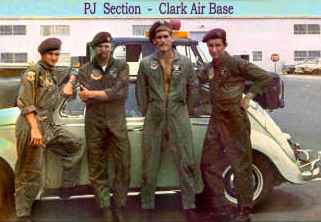 He
hated dishes, didn’t want to be a cook, cop or maintenance man. That’s
when 2 sharp looking, bloused boot, beret wearing men walked into 1 of
the training sessions. Having always been above average physically, he
thought, “I’ll give it my best shot.”
He
hated dishes, didn’t want to be a cook, cop or maintenance man. That’s
when 2 sharp looking, bloused boot, beret wearing men walked into 1 of
the training sessions. Having always been above average physically, he
thought, “I’ll give it my best shot.” 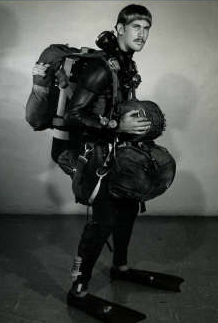 Next
stop was Key West, Fl. for Underwater Swimmers School given by the Navy
Seals. This was a tougher row to hoe considering ones need for air.
Everyone washed out but the PJs. One came close but group effort saved
him.
Next
stop was Key West, Fl. for Underwater Swimmers School given by the Navy
Seals. This was a tougher row to hoe considering ones need for air.
Everyone washed out but the PJs. One came close but group effort saved
him. 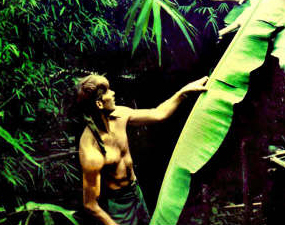 There
were plenty of search missions for missing ships and aircraft and long
days over vast ocean and in dense jungle. There were about ˝ dozen
Typhoon evacs to get aircraft out of the path of turbulence. Plus he got
to see The Orient.
There
were plenty of search missions for missing ships and aircraft and long
days over vast ocean and in dense jungle. There were about ˝ dozen
Typhoon evacs to get aircraft out of the path of turbulence. Plus he got
to see The Orient. 